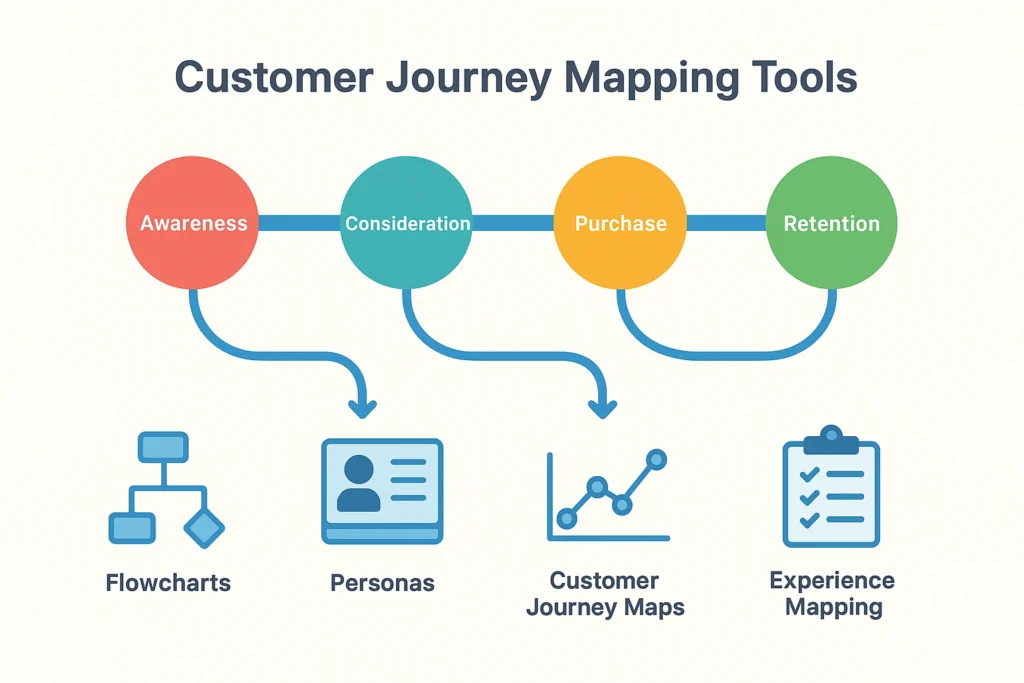Customer Journey Mapping Tools are essential for understanding your customers’ experiences. Knowing what customers are experiencing in your customer experience can be challenging. As a CX Manager, you observe and search for pain points, optimize touchpoints, and improve overall satisfaction. Of course, if you don’t have the right tools, this can feel a little bit like drinking from a fire hose! This is where customer journey mapping tools can help.
Customer mapping tools can help develop a visual of your customer experience, identify improvement opportunities, and keep your company aligned. In this article, I will outline my top selections for customer journey mapping tools based on evaluation testing that I have conducted and independent reviews from real users. You will see tools that suit a wide range of target audiences, from low-budget customers to higher-end products that would fit most company requirements!
What is a Customer Journey Mapping Tool?
The customer journey mapping is not easy. There are so many variables and combinations with many possibilities that many times it can be extremely complex and detailed. So it is understandable to look for technological support.
Customer journey mapping tools collect both qualitative and quantitative data about digital user interactions and provide you with that data in the simplest way possible to help support you in the development of your customer persona. At their most basic level, these tools are digital whiteboards or mind maps of your client journeys.
Characteristics of Customer Journey Mapping Tools
- Visual features: When selecting customer journey mapping tools, look for those that offer an easy, intuitive visual interface for building journey maps. Features such as drag-and-drop functionality and options to add information are key. Visual stories of characters will always help you think about and visualize your customer journey process!
- Collaborative features: Many customer journey mapping tools allow multiple stakeholders, or even multiple teams, to work on the same customer journey map collaboratively in real time. Cross-functional teams and remote teams can greatly benefit from this feature.
- Templatization features: Customer Journey Mapping Tools allow you to template common stages and touchpoints for efficiency. Many common customer journey stages, touchpoints, interactions, and other elements make more sense when templated. This makes the mapping process more efficient, as you can document standard elements and then add custom or unique pieces to tailor your customer journey map.
- Data integration: It’s important for modern marketers to have all their tools integrated seamlessly—and this applies to customer journey mapping tools as well. Ideally, the tool should offer strong integration capabilities so you can incorporate real-time data, feedback, and performance metrics into your journey maps. This enhances the accuracy and overall usefulness of the maps.
- Persona integration: Journey mapping tools that allow you to incorporate consumer profiles, segments, and personas into the planning process are extremely helpful. They ensure that the varying expectations and needs of different customer groups are represented, making it easier to interpret, analyze, and refine your customer journey.
- Analysis and reporting: One of the standout features of Customer Journey Mapping Tools is the ability to analyze pain points, quantify customer satisfaction at each stage, and measure the impact of changes in the customer experience.
Advantages of Customer Journey Mapping Tools
Customer experience visualization: Empathy, as you will often hear, is the gateway to understanding your customer’s mind and building a meaningful relationship. Only when you can truly empathize with their experiences can you begin to visualize their journeys and purchasing behaviors. Customer journey maps allow you to visualize the entirety of these journeys, including emotions, reactions, interactions, and touchpoints.
Customer needs awareness: All the elements mentioned in the previous point become valuable only when distilled into insights. These insights lead to actionable decisions and meaningful changes in your customer experience. They also help you segment your customers into clearly defined categories or groups with unique journeys, allowing for more deliberate and tailored strategies. By leveraging Customer Journey Mapping Tools effectively, you can create a truly seamless and satisfying experience for every customer.
Identifying areas of improvement and opportunities: Customer Journey Mapping Tools can highlight pain points—issues and challenges faced by customers during specific interactions. This makes it easier for marketers to address these issues, close experience gaps, and enhance communication with customers as part of the solution.
Cross-departmental collaboration: Customer Journey Mapping Tools help teams collaborate across departments with clarity. Due to the omnichannel nature of customer journey maps, cross-departmental collaboration becomes seamless, and task ownership is clear for all stakeholders. It enables a more holistic approach to customer experience management. When your entire organization works together across functions, it can collectively deliver an exceptional customer experience.
Data-informed recommendations: “The best Customer Journey Mapping Tools integrate feedback, data, and analytics tools to continuously enhance the customer experience. You can also use these maps to report and measure the impact of changes and interventions in a quantifiable way.
Customer-centric approach: You might be wondering how customer journey mapping tools promote customer-centricity. There are several ways they provide value in this area. First, these tools foster a customer-first mindset across all levels and departments within an organization through shared visibility and coordination. Second, customer journey mapping supports continuous improvement. By enabling users to regularly update and refine maps, organizations can adapt to evolving customer needs and expectations—and integrate them into ongoing CX strategies effectively.
Top Customer Journey Mapping Tools
1. Figma
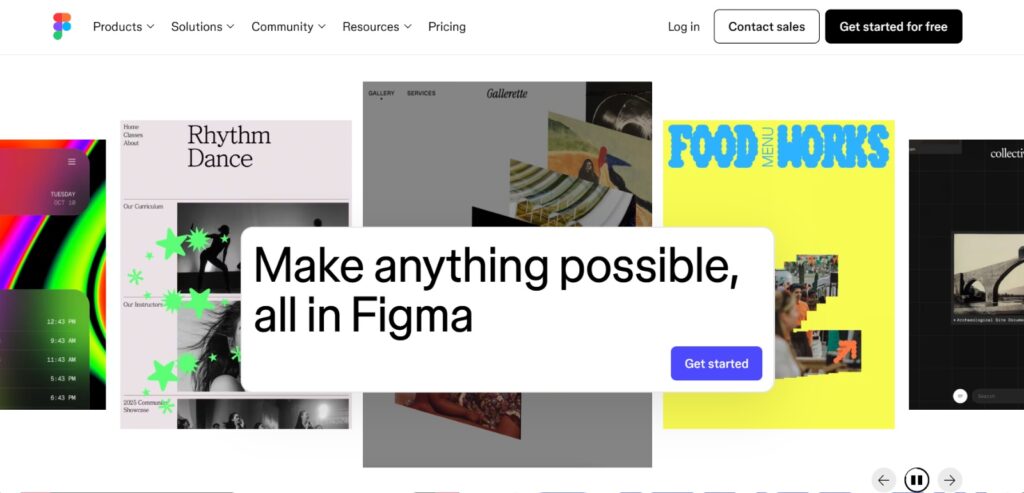
Figma is a versatile Customer Journey Mapping Tool that supports collaborative design. It is still a fantastic option for collaborative interface design. Being web-based, it allows multiple people to edit simultaneously, enabling design teams to work together even when they’re not on-site. Additionally, other stakeholders can easily follow along and provide real-time feedback. The latest updates have added a wealth of new prototyping features, and Figma now integrates with many other tools to enhance workflow.
The sticky notes are a great touch! You can quickly jot down ideas, add as many notes as you like, move them around, and mix and match them. The drawing tools are excellent too—you can sketch out concepts, create diagrams, and even add emojis. It makes mapping the customer journey a fun and visual experience!
And let’s not forget the live cursor tracking. You can instantly see where everyone is on the board and how they’re interacting with the content. It’s a feature that can potentially save your entire team a lot of time, especially when using this type of Customer Journey Mapping Tools.
Key Features:
- Real-time Collaboration – Multiple users can design and collaborate live.
- Cloud-based – Designs are viewable on any device without installations.
- Vector Editing – Complete vector tools when precision design work is important.
- Components & Styles – Elements can be reused, and design systems can be consistent.
- Prototyping – It is easy to click through interactive flows and animations.
Pros:
- Real-time collaboration across devices
- Powerful prototyping functionalities
- Large plugin ecosystem
Cons:
- Some advanced features can be a learning curve for new users
- Pricing changes for 2025 have increased costs for some plans
Pricing:
- Free plan
- Paid plans begin at $20 per editor/month.
2. Miro
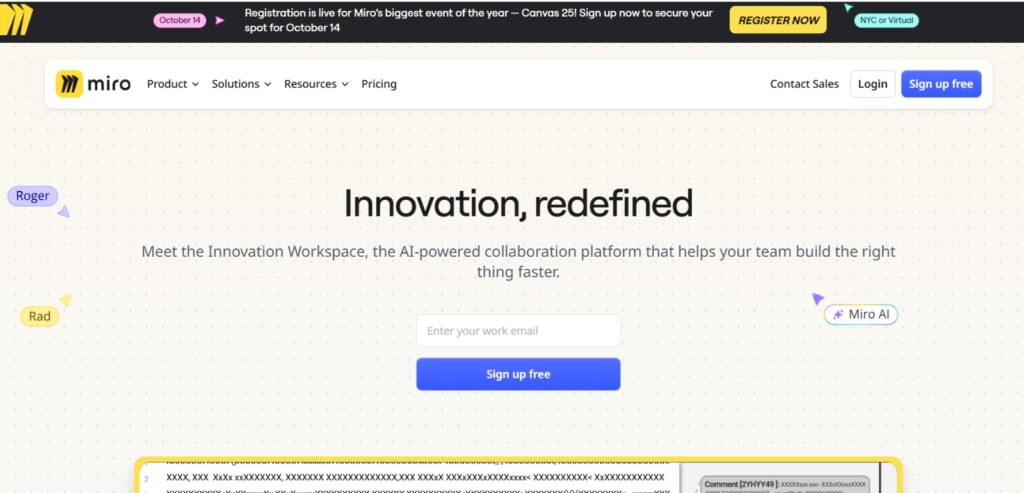
Miro is one of the intuitive Customer Journey Mapping Tools for collaborative planning. It is fantastic for whiteboarding and, as a planning tool, you can use an outline instead of a linear timeline to map the components of a workflow. It makes it easy for multiple people—if you have several collaborators helping you develop your plan, everyone can easily join in and add their ideas and thoughts. Miro is great for non-technical people who need assistance visualizing where everything is going and how it all connects.
If you have many different ideas but aren’t sure how they all connect, use Miro to organize them in an outline structure. You can then rearrange the ideas until you get a structure that makes sense—if you want to create an outline. You can also insert images and links to other resources if you want to add them to your map. Customer Journey Mapping Tools can help you visualize complex ideas effectively.
Key Features:
- Unlimited Canvas – Offers a versatile digital whiteboard that is boundless for brainstorming and planning.
- Live Collaboration – Team members can collaboratively work live from anywhere.
- Pre-Built Templates – Provides pre-designed boards for flow charts, mind maps, retros, and more
- Sticky Notes & Drawing Tools – You can easily build ideas, sketches, and comments directly on the board.
- Video & Chat Integration – You can chat and hop on a video call with built-in tools to communicate while collaborating.
Pros:
- You can map at a large scale
- You have endless templates at your disposal
- Excellent strong collaboration features
Cons:
- It has a lot going on which can be overwhelming initially for new users
- Some advanced features are only available with higher plans
Pricing:
- Free plan – Limited features
- Paid plan – Starting at $10 user/month
3. Smaply
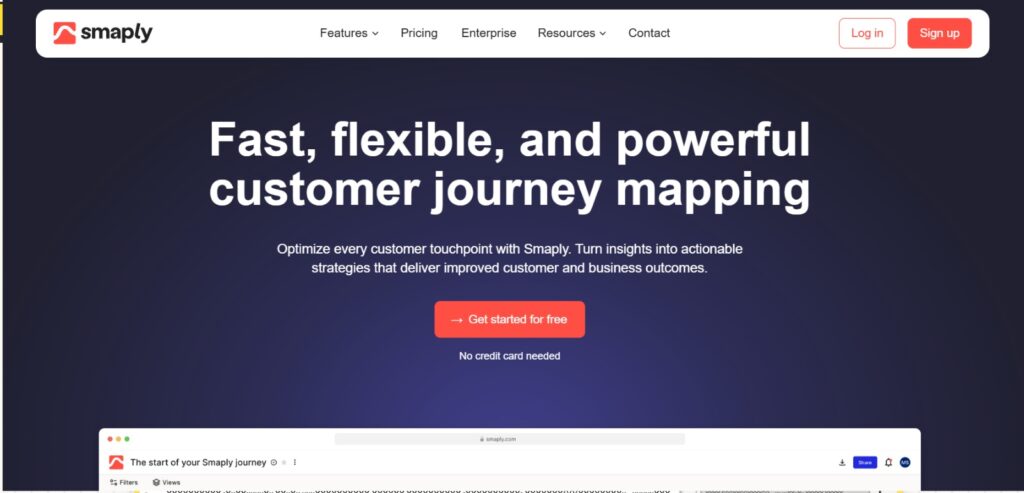
While Smaply is primarily focused on customer journey mapping, it also offers useful features to create personas, stakeholder maps, and journey maps. Because Smaply is specifically designed for journey mapping, it serves as a specialized tool for design teams focused on customer experience design. making it one of the top Customer Journey Mapping Tools.
The tool can be used for topics ranging from marketing campaigns and sales funnels to complex problem-solving across any business discipline. Use the tool to visualize and collaborate on your customer experience map with people from different functions within a company, at the level of detail you want—whether announcing an overarching strategy or planning an individual project.
As a specialized Customer Journey Mapping Tool, Smaply helps design teams gain deeper insights. It’s visual representations of the customer experience will help you identify where more detail and further research are needed to complete your maps.
Key features:
- Participant Recruitment – Facilitates the connection of researchers with eligible participants for trials.
- Customizable Screening – Allows the researcher to set the criteria for a potential participant to be screened for
- Data Privacy – Provides secure and compliant ways of dealing with participant information
- Multi-Channel Outreach – Sends emails, texts and calls for participant engagement.
- Dashboard and analytics – Dashboard to view recruitment, and analytics to view campaign performance
- Integration capabilities – Can integrate with other clinical trial management systems.
Pros:
- Specific feature sets for journey mapping
- Supports the development of personas and stakeholder mapping
- Features for collaborative teamwork on projects
Cons:
- Not as broadly useful for more general prototyping needs
- The user interface may be seen as dated compared to more contemporary tools
Pricing:
- Free plan available
- Paid plans start from €390 per editor.
4. Sketch

Sketch is a widely used vector-based design program typically used for UI and UX design and is favoured by Mac users. Think of Sketch as a way for designers to construct wireframes, prototypes, and high-fidelity interfaces quickly and easily. Sketch is unique because of its simple-to-use interface, reusable design components called Symbols, and extensive plugin ecosystem, making it a valuable addition to Customer Journey Mapping Tools for visualizing and designing customer experiences.
Sketch has an architecture that is useful for teams managing many screens in one project (artboards) and has good options for exporting designers’ work for developers. As one of the versatile Customer Journey Mapping Tools, it supports effective visualization of user experiences. Although Sketch is a Mac desktop app, its demonstrated commitment to design systems, and collaboration through shared libraries Sketch is still a good option for individual designers and teams to build digital products.
Key features:
- Vector-Based Design — Design with vector-based graphics that can grow to any size for UI and icons.
- Symbols & Reusable Components — Creating Material Design components that can be updated globally.
- Artboards — Design multiple screens or pages, all within the same file.
- Plugins & Integrations — Extend capabilities with a huge plugin library.
- Shared Libraries — If you’re working in a team, shared styles and reusable components.
Pros:
- Full vector editing capability
- Large plugin library
- Built for macOS
Cons:
- MacOS only
- Collaborative features are not as robust as other competitors.
Pricing:
- Good 30-day free trial
- Standard plan at $9 per editor/month
Suggested blogs to read:
Best Customer Support Tools
Best Customer Engagement Platforms
5.TheyDo
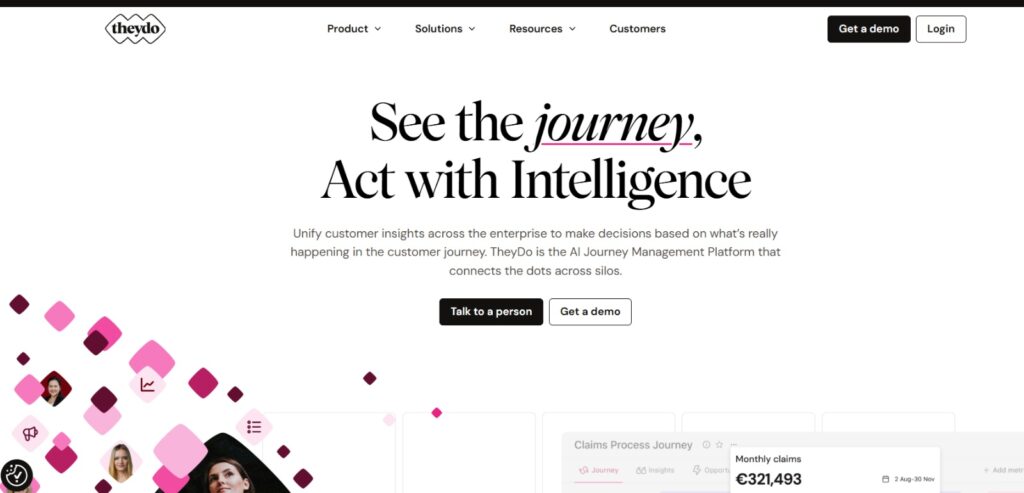
TheyDo is a versatile journey management tool tailored to help organizations better understand and optimize customer experiences across the entire customer lifecycle. It helps people improve customer experience because they gain a clearer understanding of the journey and the pains and challenges involved, making it one of the effective Customer Journey Mapping Tools.
TheyDo is focused primarily on journey mapping the entire flow of a customer as they encounter the business across many channels and touchpoints. It provides customers with a very different view of their experience, helping organizations see where the gaps are, where frustrations lie, where the delights occur, and what truly impacts satisfaction and loyalty.
Where TheyDo outperforms the competition is in its ability to align organizational efforts across functions, so client services, customer experience, product, marketing, and leadership are all on the same page within one platform—leading to a collaborative understanding of the customer experience, whether you like it or not. This alignment works because organizational improvement initiatives are no longer siloed; they are driven by active and clear decision-making and a shared understanding of the overall direction of the experience.
One of TheyDo’s most important advancements is that it ensures all improvement initiatives are part of a plan, directly or indirectly supporting each organization’s business goals and customer needs, making it a standout option among Customer Journey Mapping Tools.
Key features:
- Journey Mapping- Visualise customer journey across touchpoints
- Centralized Workspace- Centralize journeys, personas and insights
- Opportunity Tracking- Identify and prioritize areas for improvement
- Persona Linking- Link journeys to the personas
- Team Collaboration- Collaboratively work together on journeys in real-time with the team.
Pros:
- Specifically designed for end-to-end journey management
- Allows teams to directly correlate initiatives and backlogs to journey insights
- Opportunity mapping/prioritization as part of the workflow
- Integrates with Jira, Miro, and DevOps for aligned execution
- Provides AI-generated ideas on gaps, needs and opportunities
Cons:
- Pricing is an enterprise tier
- May be too much for smaller teams or limited journey mapping
- Less focused on pixel-perfect design/prototyping than Figma
Pricing:
- Free trial available for limited journeys/editors
6. Fullstory
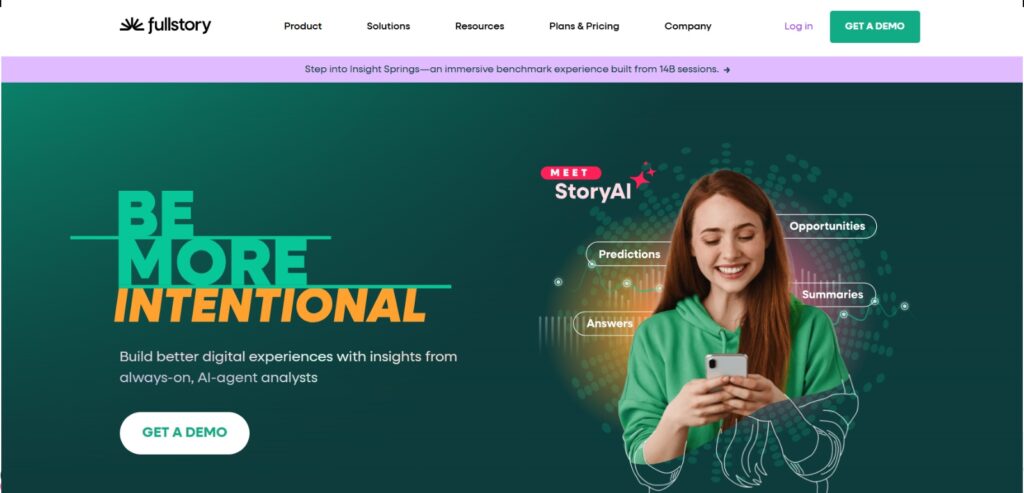
FullStory is a very complete digital experience analytics system that provides much more detailed behavioural data than mapping a journey. FullStory focuses on enabling businesses to develop a deep understanding of how users interact with their websites and apps. To that end, FullStory quantifies every click, scroll, page change, and user interaction with great detail and depth. We are not only able to create a view of the customer journey but also determine the “why” behind actions and behaviors, making it a powerful addition to Customer Journey Mapping Tools.
Unlike many of the alternatives that focus only on certain points of the journey, and might only provide high-level metrics or a top-line overview, FullStory has session replay features and an auto-capture engine that records the user session without the need to tag every element. It simply records everything the user does. Teams can then get a visual recording of each session and watch exactly what the user did, learn about points of friction and pain, bugs, and learn about intent in real time, making it a powerful solution among Customer Journey Mapping Tools.
Key Features:
- Journey Mapping – Visually map customer journeys through all customer touch points, measuring emotions, needs, and pain points.
- Centralized Workspace – Create journeys, personas, and insights all in a centralized location for team alignment.
- Opportunity Tracking – Identify gaps and stress points, prioritize gaps and improvement areas based on journeys´ data.
- Persona linking – Link specific journeys to customer personas so that experience planning is better targeted.
Pros:
- Tracks every click, pageview, scroll, form fill, or more—that all happens automatically, without you needing to tag everything.
- We can see what users actually experienced in high-fidelity replays.
- Visual pathing tools show how people move, where they drop off, or more importantly, what path converts the best.
- Strong support for data pipelines, other collaboration tools, etc.
Cons:
- There may be a learning curve that one must overcome in order to leverage these comprehensive key features.
- Costs are dependent on scale and wants, needs.
Pricing:
- Free trial available.
7. Heap.io
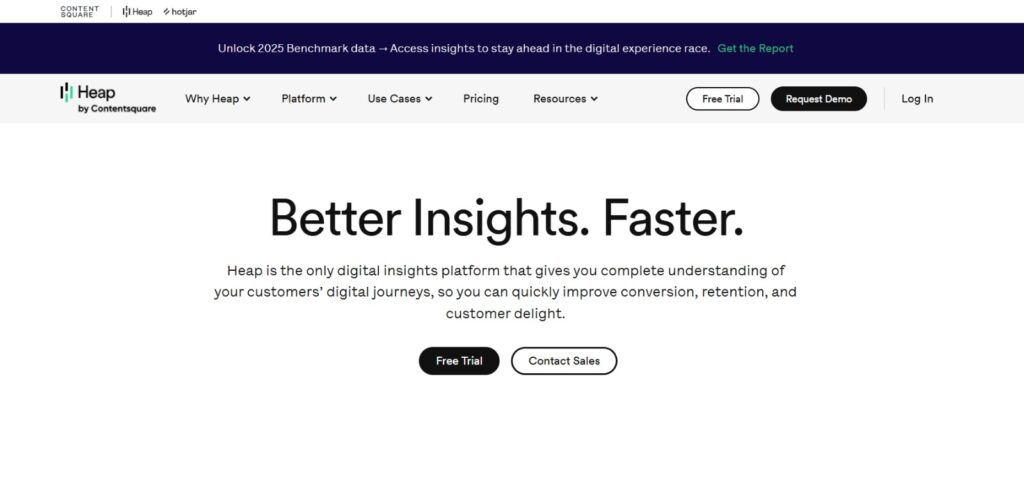
Heap is a next-generation product analytics platform designed to give teams a complete, data-driven view of user behavior—without relying on traditional manual event tagging. Unlike legacy analytics platforms that require developers to define and tag each user interaction in advance, Heap uses Automatic Data Capture to automatically collect every click, tap, swipe, form submission, and page view from the moment it is installed—across any timeframe, making it an essential tool among Customer Journey Mapping Tools.
By taking this automated approach, teams can analyze product behavior retroactively, gaining faster insights and the confidence that no events were missed. This enables maximum flexibility in exploring and understanding user engagement, without needing to anticipate what will be important in advance. Instead, teams can ask questions on the fly and get immediate answers, making product decisions more agile and informed, especially when using Customer Journey Mapping Tools.
Key features:
- Retrospective Analysis: Analyze past data without defining events in advance.
- User Journey Mapping: Map all user journeys and identify areas of friction.
- Segmentation, Group users by cohorts, attributes or actions.
- Conversion Funnels: Build funnels and then analyze them to understand where users dropped off.
- Session Replay: Replay real user sessions – get the true usability behind the data.
Pros:
- Good segmentation features.
Cons:
- Can be very complex for a beginner.
- Setup of custom events can be difficult.
Pricing:
- Free plan with limited data retention and features.
8. Glassbox
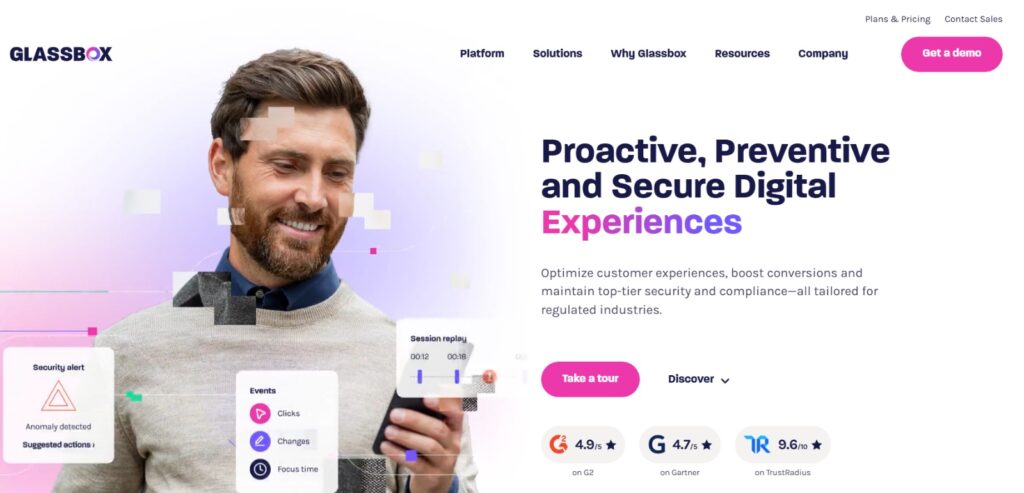
Glassbox is a powerful customer experience analytics platform that provides brands with real-time, actionable insight into how users engage with web sites and mobile apps. It doesn’t simply take the stuff you normally track in analytics to the next level – Glassbox combines session replay, heatmaps, AI capabilities, and performance measurement to provide a complete view of the digital customer journey.
This is the leading Customer Journey Mapping Tools for understanding user behavior. To put it simply, Glassbox helps organizations really understand not just what users are doing, but why users are doing that. It captures every interaction with the web or app automatically – whether it is tap, scroll, page error or form fill – without tagging, so that teams never miss a moment that could uncover a friction point, usability issue, or boost conversion.
Key Features:
- Session Replay: You’ll see real-time recordings of user sessions, so you’ll see what users are doing on your site/app.
- Journey Mapping: You’ll see the full journey of a customer across multiple platforms/touchpoints.
- Friction & Error Detection: Automated detection of where users are experiencing issues, like rage clicks, errors, broken UI, etc.
- Conversion Analytics: You’ll see where users dropped off in funnels and produce optimizations for actions users take towards conversion.
Pros:
- You get data-driven metrics based on user behaviour.
- Real-time capturing of data.
Cons:
- Pricing can be out of reach for smaller businesses and startups.
- The user interface may not be as user-friendly as others.
Pricing:
- Pricing is custom.
Conclusion
There are plenty of helpful advice columns and articles that compare, evaluate, and pit customer journey mapping tools against one another. These can be useful for research — ideally after you’ve considered the list we’ve just discussed.
But this blog is more about helping you take action on the advice you’ve been given.
How? Each of the incredible customer journey mapping tools mentioned above offers a free trial. Once you’ve had a quick look at their features — which you probably have by now — shortlist your top choices and sign up for the trials. Run them in parallel for a week or two. This real-time, hands-on comparison will give you far better clarity than specs alone.
After gaining this first-hand experience with Customer Journey Mapping Tools, you’ll be well equipped to choose the right tool for your needs — ready to arm yourself for the journey ahead.
Or should we say… “map” yourself for the journey ahead?
FAQs
1. What is a customer journey map?
A customer journey map — also known as a user journey map or service blueprint — is a visual representation of how customers interact with and experience your website, products, or business across various touchpoints.
2. How do I create a customer journey map?
There are many customer journey mapping tools and visualization tools available today. However, not all tools offer the same features or functionality. To find the right one for your needs, it’s important to compare tools based on what they offer and how they align with your goals.
3. What does a customer journey mapping tool cost?
The cost of a customer journey mapping tool can vary widely depending on the features included. There are affordable and even free options available, as well as enterprise-level solutions with more advanced capabilities.
4. Are there industry-specific customer journey mapping solutions?
Yes, many customer journey mapping tools offer industry-specific solutions that cater to the unique challenges and requirements of different sectors.
